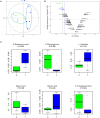Multi-omics Analysis of Gut Microbiota and Metabolites in Rats With Irritable Bowel Syndrome
- PMID: 31192167
- PMCID: PMC6549239
- DOI: 10.3389/fcimb.2019.00178
Multi-omics Analysis of Gut Microbiota and Metabolites in Rats With Irritable Bowel Syndrome
Abstract
Irritable bowel syndrome (IBS) is a common gastrointestinal dysfunctional disease. The pathophysiology of IBS is, however, largely unknown. This study aimed to determine whether evaluation of fecal metabolite and microbiota profiles may offer an opportunity to identify a novel pathophysiological target for IBS, and to reveal possible gut microbe-metabolite associations. By using gas chromatography coupled to time-of-flight mass spectrometry (GC-TOFMS) and 16S rRNA gene sequencing, we measured fecal metabolites and microbiota of the control and water avoidance stress (WAS)-induced IBS rats. We found a significantly differential metabolite profile between the IBS and control groups; a cluster of metabolites was also found to be significantly associated with the amount of defecations. Moreover, the WAS group exhibited a decreased alpha diversity of the microbial population as compared to the control group. However, the characteristics of gut microbiota could not differentiate the IBS group from the control group. Correlation of the metabolite level with the number of microbial genera showed no significant association between the control and IBS groups. This study provides a global perspective on metabolomics and microbiota profiling in WAS-induced IBS model and a theoretical basis for research on the pathophysiology of IBS.
Keywords: 16S rRNA gene sequencing; correlation analysis; fecal metabolomics profiling; irritable bowel syndrome (IBS); water avoidance stress (WAS).
Figures





Similar articles
-
Identification of Gut Microbiota and Metabolites Signature in Patients With Irritable Bowel Syndrome.Front Cell Infect Microbiol. 2019 Oct 18;9:346. doi: 10.3389/fcimb.2019.00346. eCollection 2019. Front Cell Infect Microbiol. 2019. PMID: 31681624 Free PMC article.
-
Gas chromatography/mass spectrometry based metabolomic study in a murine model of irritable bowel syndrome.World J Gastroenterol. 2018 Feb 28;24(8):894-904. doi: 10.3748/wjg.v24.i8.894. World J Gastroenterol. 2018. PMID: 29491683 Free PMC article.
-
FMT and TCM to treat diarrhoeal irritable bowel syndrome with induced spleen deficiency syndrome- microbiomic and metabolomic insights.BMC Microbiol. 2024 Oct 26;24(1):433. doi: 10.1186/s12866-024-03592-y. BMC Microbiol. 2024. PMID: 39455910 Free PMC article.
-
Alterations of Gut Microbiota in Patients With Irritable Bowel Syndrome Based on 16S rRNA-Targeted Sequencing: A Systematic Review.Clin Transl Gastroenterol. 2019 Feb;10(2):e00012. doi: 10.14309/ctg.0000000000000012. Clin Transl Gastroenterol. 2019. PMID: 30829919 Free PMC article.
-
The gut microbiome and irritable bowel syndrome: State of art review.Arab J Gastroenterol. 2018 Sep;19(3):136-141. doi: 10.1016/j.ajg.2018.02.008. Epub 2018 Jun 20. Arab J Gastroenterol. 2018. PMID: 29935865 Review.
Cited by
-
Role of gut microbiota in identification of novel TCM-derived active metabolites.Protein Cell. 2021 May;12(5):394-410. doi: 10.1007/s13238-020-00784-w. Epub 2020 Sep 15. Protein Cell. 2021. PMID: 32929698 Free PMC article. Review.
-
'Omics' approaches for studying the microbiome in Alopecia areata.J Investig Med. 2020 Oct;68(7):1292-1294. doi: 10.1136/jim-2020-001426. Epub 2020 Sep 21. J Investig Med. 2020. PMID: 32958525 Free PMC article.
-
Dysbiosis in the Gut Microbiome in Streptozotocin-Induced Diabetes Rats and Follow-Up During Retinal Changes.Invest Ophthalmol Vis Sci. 2021 Aug 2;62(10):31. doi: 10.1167/iovs.62.10.31. Invest Ophthalmol Vis Sci. 2021. PMID: 34431974 Free PMC article.
-
Identification of Gut Microbiota and Metabolites Signature in Patients With Irritable Bowel Syndrome.Front Cell Infect Microbiol. 2019 Oct 18;9:346. doi: 10.3389/fcimb.2019.00346. eCollection 2019. Front Cell Infect Microbiol. 2019. PMID: 31681624 Free PMC article.
-
Multi-Omics Analysis to Generate Hypotheses for Mild Health Problems in Monkeys.Metabolites. 2021 Oct 13;11(10):701. doi: 10.3390/metabo11100701. Metabolites. 2021. PMID: 34677416 Free PMC article.
References
-
- Bonaz B., Tache Y. (1994). Water-avoidance stress-induced c-fos expression in the rat brain and stimulation of fecal output: role of corticotropin-releasing factor. Brain Res. 641, 21–28. - PubMed
Publication types
MeSH terms
Substances
LinkOut - more resources
Full Text Sources
Miscellaneous

